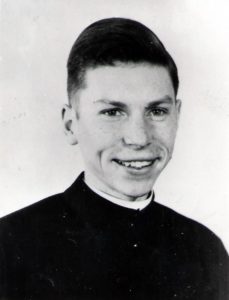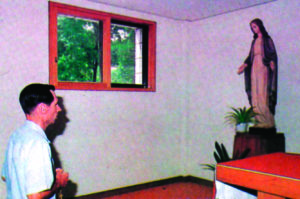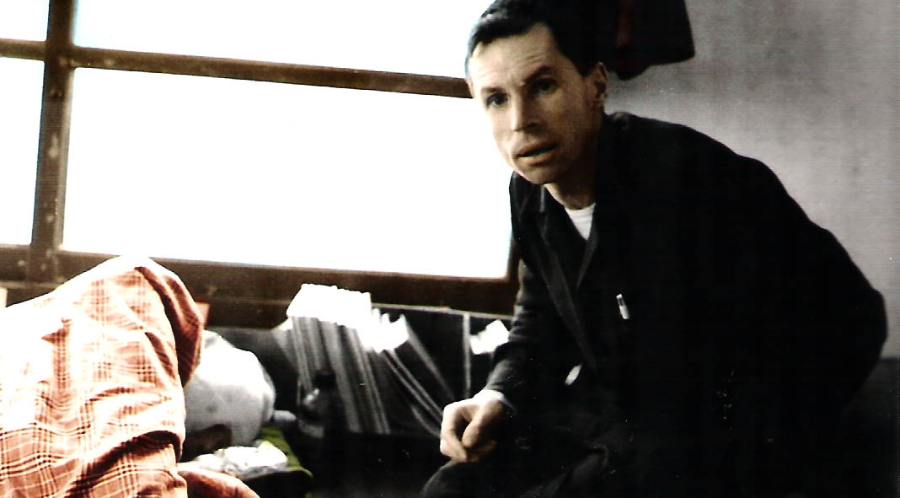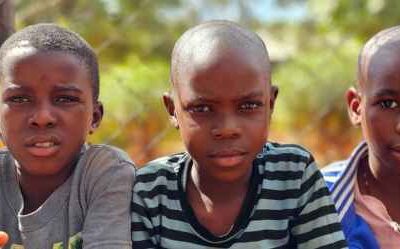“THANK YOU LORD, I NEEDED THAT”
As the Feast Day of St. Thérèse of the Child Jesus approaches, it is good to recall how the Church Doctor and Carmelite nun broke like teams of wild stallions into Venerable Aloysius Schwartz’s (founder of World Villages for Children) soul.

Fr. Al in seminary
In 1945, Al was a precocious 15-year-old, two years into formation at St. Charles College High School, a large diocesan preparatory seminary outside of Baltimore. Because he had seen complacency and a spiritual malaise cover much of the seminary, he had grown rather bored. Although a zeal was budding in him to serve Christ as a missionary in a foreign land, he didn’t walk the straight and narrow during those early years of formation.
Gifted with great intellect and a desire for prayer, Al also horsed around with classmates. By his second year, he was in the thick of the pranks, mischief, and hazing of his seminary classmates.
One day, Al became entangled in a since-forgotten transgression and was summoned to the office of the Headmaster, Fr. Joseph White. It was the custom then that misbehaving seminarians would be spanked with a wooden sandal. The unwritten rule was to spank the offender with as many strokes as was necessary to bring about tears. The school record was fifty-two; Al made it to thirty-five.
“That spanking, in a healthy way, had a profound effect on him,” said his brother Lou, also a seminarian at St. Charles. “It seemed to awaken him to some of the things he was straying from. He was humbled.”
Looking back years later in the Far East, Al agreed: “After leaving Joe White’s room, I limped downstairs to the chapel, knelt before the Blessed Sacrament, and said simply, “Thank you, Lord, I needed that.”
THE MIGHTY OAK
It was shortly after the spanking that Thérèse came into his life. Someone had thought to give young Al her autobiography, The Story of a Soul. As he flipped the pages, he felt his entire life begin to shift. He began to see the French saint’s impulse to embrace privations, hiddenness, and the dignity of suffering as the truest path to the love of God. It would be through constant practices of “little sacrifices of love” that Al, like St. Thérèse , could begin to approach the furnace of God’s throne.
As an eighth-grader at Holy Name in Washington D.C., he began to gravitate toward the saints, but no single saint managed to captivate him as Thérèse “the Little Flower.” He would later write in his private journal, “the substance of her writings is inspired with the fire of the Spirit and blood of the Lamb.” He would later request of his spiritual director in Korea, Carmelite nun Mother Gertrude, that she pray fervently that “Thérèse herself puts into my heart, my bloodstream, and the very marrow of my bones what is contained in [The Story of a Soul].
Over the course of his life, Fr. Al would read the autobiography of the saint’s more than two dozen times, often in her own French hand – and made it mandatory reading for each of his Sisters of Mary nuns.
In the introduction to Fr. Al’s book, To Live Is Christ, a book of spirituality for the Sisters of Mary, he pleaded for the Sisters to pursue
Over the course of his life, Fr. Al would read the autobiography of the saint’s more than two dozen times, often in her own French hand – and made it mandatory reading for each of his Sisters of Mary nuns.
In the introduction to Fr. Al’s book, To Live Is Christ, a book of spirituality for the Sisters of Mary, he pleaded for the Sisters to pursue

Fr. Al dedicated his life and his work to Mary, Virgin of the Poor.
Thérèse’s pursuit for absolute perfection. As he lay dying from the ravages of ALS, he asked the Sisters at his bedside to read to him the writings of the Little Flower.
He once wrote of his patron saint: “Thérèse and Jesus became one. Thérèse disappeared in the love of Jesus as a drop in the ocean of water. … she had a real attraction to the cross that could only be explained by the real presence of Jesus in her heart. Because of her remarkable courage in the midst of every trial and suffering, she more closely resembles a mighty oak tree than a little flower.”
It is no coincidence that Thérèse and Fr. Al both offered their entire lives in service to building God’s Kingdom; Thérèse directly to Jesus, and Al through the Virgin of the Poor to Jesus. “For some time I have indulged in the fancy of offering myself up to the Child Jesus as a plaything for Him to do what he liked with me,” she wrote in The Story of a Soul.
Before Fr. Al took off to serve the poorest of the poor in Korea in 1957, he said virtually the same to Mary. And the world began to change.
Below is an excerpt from a Homily by Father Al. Please feel free to take this to your prayer time.
Holy Eucharist (Source of Energy and Zeal to Work for Jesus)
St. Therese, after her first communion, felt within her a great hunger and thirst for the Eucharist. This became the focal point of her life. She loved to go to communion. She loved to adore Jesus in the Eucharist. In a sense, she became addicted to the Eucharist. She became a “Eucharistic-holic”, as I mentioned in the previous sermon.
There was another result of her first encounter with Jesus in the Eucharist, and this second result astounded her and amazed her. This result was the will to suffer. She felt arising from the depths of her being this will and desire and longing to suffer for Jesus.
This was not something sentimental or romantic, something which an adolescent girl, of fifteen or sixteen years old, would dream of. It was not a game. It was not playacting. It was something very real. Therese was always extremely realistic and objective. She truly wanted and desired pain, what is difficult and uncomfortable and humiliating-for Jesus. This desire, which unconsciously and naturally arose from her heart, surprised her. She says, “How can this be?”
This is so contrary to human nature. Our flesh and blood, our human nature is so constituted that it desires
pleasure and fears pain. It is drawn very strongly to what is pleasurable and what is comfortable. At the same time, there is a great fear and terror in the face of all pain and whatever is uncomfortable. This is the way we are made. Jesus has the same human nature and He shows the same reaction in the face of pain. There is a trembling, a seating of blood, a fear, a terror. He wants to run. This is natural. This shows that He is human. Therese realized that this is the way human nature is so constituted, and yet, something in her had changed. She realized that this could only be the action of Jesus in her heart and her soul.
So Therese, really filled with this spirit of love which Jesus poured into her heart especially at the time of her First Communion, and He does it at each additional Communion and every time we are united with Him in adoration of the Eucharist, driven by this love, and impelled by this love, and inspired by this love, Therese offers herself as a victim, as a holocaust to the divine love. A holocaust is a burnt offering. It’s a lamb, a sheep, a goat, which is consumed by fire and burnt as an offering to God.
Therese offered herself, body and soul, to God as a victim, a holocaust to His divine love. This type of prayer, again, requires great courage. There is no playing a game here. There’s no play-acting. It is real. She realized that God would hear this prayer, and in effect, He would send her suffering; but she realized also that in each suffering there is the courage to endure it, the grace to bear it. This is always important to understand.
We are afraid instinctively of suffering, of what is uncomfortable and difficult, but in every difficulty, in every trial, in every tribulation, in every suffering, God includes the grace to endure it. “God is faithful,” says St. Paul. “He never permits us to be tried or tested beyond our strength. With every trial, He gives us the strength to endure it, the grace to bear it.”
And so, St. Therese offers herself as a victim to Divine Love, and she prays that others will follow her example, and that there will be a legion of little souls, as she speaks of them, who would have the courage to offer themselves as little victims to divine love.
The Eucharist is the bread of life. It gives you this divine energy, this divine vitality, and it stirs up within you this will to work and to do something for Jesus in this short period of time we have here on earth. Don’t waste this time.
The Eucharist, in a sense, is a holy stimulant. Coffee is a stimulant. In the evening, if you drink coffee maybe at nine or ten o’clock at night, try it if you don’t believe me, drink five or six cups of strong coffee, and you’ll find you’re awake. You might have been very tired but suddenly you’re wide awake, and you’re running around singing and jumping and dancing and you can’t sleep. Maybe for two or three days you can’t sleep. This caffeine is a stimulant! Well, the Eucharist is a stimulant. It doesn’t put us to sleep. It doesn’t make us lazy. It seizes our heart and it moves us forward, and we feel this divine compulsion and energy to do something for Jesus.
Also, the Eucharist is a holy nutrient. It not only stimulates us; it gives us the strength to do something — the courage. You need not only the will but you need the strength and the energy; and, this comes from the Eucharist.
So, let us think of these things, and think of this mystery of the Eucharist. Love to spend time before Jesus in the Eucharist, Jesus-Bread, and enjoy this fragrance of Christ, and rest in this power which comes from ‘the Eucharist.
If we truly receive Jesus and adore Jesus in the Eucharist with faith and love, our faith and love of the Eucharist will increase daily, and we will feel arising from our hearts this will to suffer which in our case, will be expressed by our will to work for Jesus, a will to do something to please Jesus and the will and the desire and the driving ambition specially to save souls for Jesus.





